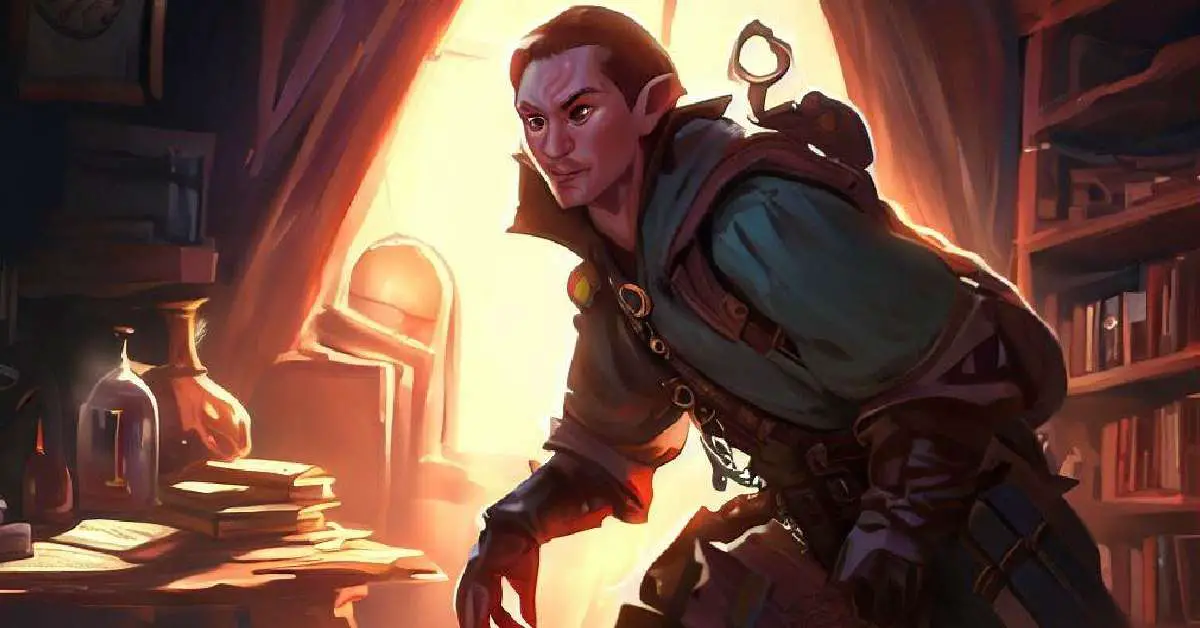
Dungeons & Dragons is far more than just a game; it’s a sprawling universe where players, armed with creativity and strategic prowess, engage in thrilling adventures and harrowing quests. Yet, within the diverse array of skills, spells, and feats that make up the game’s vibrant tapestry, one element stands out for its pivotal role in shaping the game’s dynamic and unpredictable course of action: initiative.
Understanding the concept of initiative and its impact on gameplay is key to elevating your D&D experience. The initiative system in D&D 5E sets the order of turns during combat, the heartbeat of most D&D campaigns, and therefore significantly influences the flow and outcome of these tense situations. A higher initiative can mean striking first, potentially tipping the balance of the encounter in your favor before your opponents even have a chance to act.
In simple terms, initiative is the game mechanic that determines who strikes first when combat begins, like a reflex to danger. However, it’s not a matter of pure luck or random chance, and contrary to what newcomers may think, it’s not exclusively tied to a character’s speed or agility. Calculating your character’s initiative involves a bit more than just rolling a dice.
Your character’s initiative bonus comes into play here, adding a strategic layer to the game. This bonus represents your character’s response speed in dangerous situations and it can provide an edge in combat by allowing you to act before your adversaries. But what factors contribute to this bonus, and how can you maximize it to give your character an advantage?
This guide will take you through every aspect of initiative and the initiative bonus in D&D 5E, breaking down its components and explaining how to calculate it step by step. By the end of this article, you’ll not only understand how to determine your initiative bonus, but also how to strategically utilize this mechanic to immerse yourself more deeply in the incredible world of D&D 5E. The initiative is yours. Let’s delve into the details!
Understanding Initiative in D&D 5E
In the context of D&D 5E, initiative is a system designed to introduce a structured format for determining the order of turns in combat scenarios. This isn’t a system solely reliant on luck; it also takes into account aspects of your character. Initiative is crucial in this intricate role-playing game, as it can often dictate the flow and potential outcomes of battles. So, gaining a higher initiative, and thus the opportunity to act first, can provide a crucial edge.
Upon entering combat, the Dungeon Master (DM) will traditionally command players to “roll for initiative.” This iconic phrase signifies a shift in the game’s tempo from a more casual exploration or interaction phase to a regimented, turn-based combat encounter. In response to the DM’s command, each player rolls a twenty-sided die (d20) and adds their respective initiative bonuses to the roll. The total result determines the order of turns for that specific combat, with higher totals acting first and the sequence continuing in descending order.
You may be tempted to overlook the importance of initiative, especially if you are a new player. However, let me assure you, taking the first turn can significantly influence the dynamics of a combat encounter. Acting before your opponents gives you the chance to control the battlefield, take decisive actions, or even interrupt your enemies’ strategies.
Consider this scenario: A cunning rogue attempting to disable a lethal trap, a devoted cleric rushing to heal a dying comrade, or a wizard preparing to cast a powerful spell that could turn the tide of battle. In each instance, having a higher initiative, hence reacting quicker, could dramatically change the outcome. Being able to act before the trap is triggered, heal an ally before they fall, or unleash a spell before the enemy can counter can be the difference between success and failure.
However, the pivotal question remains: How is your initiative determined? Your initiative bonus, a vital yet often misunderstood aspect of D&D, plays a critical role here. Calculating this bonus involves considering several factors, the most crucial of which is your character’s Dexterity modifier. But other elements, including certain feats, traits, spells, and magic items, can also influence it.
The Components of Initiative Bonus
Now that we have an understanding of what initiative is and its role in combat, it’s time to dive into the specifics of the initiative bonus. This is the number you add to your d20 roll when determining initiative order at the beginning of combat. Your initiative bonus isn’t a fixed value; it can change and evolve along with your character, influenced by various factors.
The three main components that contribute to your initiative bonus in D&D 5E are your Dexterity modifier, certain character feats and traits, and specific magic items and spells. Let’s take a closer look at each of these elements:
Dexterity Modifier
The backbone of your initiative bonus is your Dexterity modifier. The Dexterity ability score represents your character’s agility, reflexes, and balance. In the context of initiative, it indicates how quickly your character can react when combat breaks out.
Your Dexterity modifier is calculated by subtracting 10 from your Dexterity score, dividing the result by 2, and then rounding down. This number is then added to your initiative roll. Thus, a character with a high Dexterity score will have a larger initiative bonus, allowing them to act earlier in combat.
Feats and Traits
Certain feats and traits can also contribute to your initiative bonus. For instance, the Alert feat, available to all classes, provides a whopping +5 bonus to initiative, reflecting your character’s heightened state of alertness and quick reactions.
Racial traits can also impact initiative. For example, the “Feline Agility” trait of the Tabaxi race (from Volo’s Guide to Monsters) can potentially impact the initiative, demonstrating the race’s lightning-quick reflexes.
Magic Items and Spells
Finally, magic items and spells can provide a temporary or permanent boost to your initiative bonus. An example is the “Weapon of Warning,” a magic item that grants advantage on initiative rolls.
Certain spells can also influence your initiative. The spell “Gift of Alacrity” from the Explorer’s Guide to Wildemount provides a d8 bonus to initiative for 8 hours.
Understanding how these different factors contribute to your initiative bonus is key to not only calculating it accurately but also maximizing it for strategic advantage
Step-by-Step Guide: How to Calculate Your Initiative Bonus
With a firm grasp on the components contributing to your initiative bonus, let’s proceed with our step-by-step guide on how to calculate it. This process, while straightforward, requires a keen understanding of your character’s traits, abilities, and equipment.
Step 1: Determine Your Dexterity Modifier
The first step in calculating your initiative bonus is determining your Dexterity modifier. As mentioned before, this number is derived by subtracting 10 from your Dexterity score, dividing the result by 2, and rounding down. The outcome represents how agile and quick to react your character is, with higher numbers providing a better bonus. This number is the foundation of your initiative bonus.
Step 2: Account for Any Feats or Traits
Next, you’ll need to consider any relevant feats or traits your character possesses. For example, if your character has the Alert feat, this means they are especially quick to react to danger, resulting in an additional +5 to your initiative bonus.
Remember to also consider racial traits. If you’re playing a character from a race with relevant traits, such as the Tabaxi’s “Feline Agility,” make sure to incorporate that into your initiative bonus calculation.
Step 3: Include Bonuses from Magic Items and Spells
The final factor to consider when calculating your initiative bonus comes from any magic items or spells your character might have. Items like the “Weapon of Warning” can grant advantages on initiative rolls, while spells such as “Gift of Alacrity” can add a d8 bonus to your initiative for a duration.
Step 4: Summing It Up: Calculating the Total Initiative Bonus
Now that you’ve accounted for all possible additions to your initiative bonus, it’s time to add them all up. This includes your Dexterity modifier, any bonuses from feats or traits, and any additional bonuses from magic items or spells.
To reiterate, your total initiative bonus = Dexterity Modifier + Feat/Trait Bonuses + Magic Item/Spell Bonuses.
This calculated total represents your character’s initiative bonus, which will be added to your d20 roll when your DM calls for an initiative check at the start of combat. Keep in mind that as your character evolves and gains new abilities, items, or spells, your initiative bonus may change.
Practical Examples of Initiative Bonus Calculation
Seeing how this calculation plays out for different characters can provide a clearer understanding and make the process feel more intuitive. Let’s examine a few character scenarios:
Example 1: An Agile Rogue
Meet Tiberius, a level 5 Rogue with a Dexterity score of 18. As such, his Dexterity modifier is +4 [(18-10)/2]. Rogues are known for their agility, and Tiberius is no exception. He also has the Alert feat, which grants him a +5 bonus to his initiative. So, Tiberius’s total initiative bonus would be +9 (Dexterity Modifier of +4 and Alert feat bonus of +5).
Example 2: A Quick-footed Tabaxi Monk
Next, we have Shadow, a Tabaxi Monk. Tabaxi, being a naturally nimble race, receive a +2 bonus to their Dexterity. If Shadow has a Dexterity score of 16, her Dexterity modifier would be +3 [(16-10)/2]. Shadow doesn’t have any feats affecting her initiative, but being a Tabaxi, she might have some racial traits or class features that could impact it. For simplicity’s sake, we’ll assume she doesn’t. Therefore, her total initiative bonus is +3, all from her Dexterity modifier.
Example 3: A Wizard with Magical Aid
Finally, let’s consider Eldrin, a level 7 Wizard with a Dexterity score of 12, translating to a Dexterity modifier of +1. Wizards aren’t typically the most agile, but they make up for it with their magical abilities. Eldrin has a “Weapon of Warning,” granting him advantage on initiative rolls, and he has cast the spell “Gift of Alacrity” on himself, providing a d8 bonus to his initiative for 8 hours. Therefore, when Eldrin rolls for initiative, he would roll two d20s and take the higher roll (due to the advantage from his magic item), add his Dexterity modifier (+1), and also add the result of a d8 roll (due to the “Gift of Alacrity” spell).
These examples help illustrate how various aspects of a character can influence the initiative bonus. Whether it’s their inherent agility, alertness, racial traits, or magical enhancements, many factors can contribute to giving you that crucial edge in the turn order.
Maximizing Your Initiative Bonus: Tips and Tricks
Now that we’ve covered how to calculate your initiative bonus and examined practical examples, let’s turn our attention to tactics and strategies to maximize this bonus. While having a high Dexterity is the foundation of a good initiative bonus, there are various ways to boost it further.
Choose the Right Feats
Opting for the right feats can significantly boost your initiative. The Alert feat is a standout option here, offering a considerable +5 to your initiative. This feat not only represents your character’s keen awareness of their surroundings but also can be the difference between going first and going last.
Optimize Your Dexterity
As we’ve discussed, your Dexterity modifier is a significant factor in your initiative bonus. Therefore, improving your Dexterity score (through level-up ability score improvements, for example) can have a direct impact on your initiative. Classes like Rogues, Monks, and Rangers, which rely heavily on Dexterity, can naturally benefit from this.
Use the Right Magic Items and Spells
Certain magic items and spells can add to your initiative bonus. A “Weapon of Warning” grants advantage on initiative rolls, while the spell “Gift of Alacrity” adds a d8 bonus to your initiative for several hours. If you’re a spellcaster, keep an eye out for such spells when choosing your spell list. If you’re not, coordinate with your party’s spellcasters to see if they can cast these beneficial spells on you.
Consider Your Race
Racial traits can also impact your initiative. For example, the Tabaxi’s “Feline Agility” or the variant Human’s ability to choose a feat (such as Alert) at 1st level can be advantageous. When creating your character, consider races that offer bonuses to Dexterity or other initiative-boosting traits.
Class Features and Abilities
Certain class features can also impact your initiative. For instance, the Bard’s “Jack of All Trades” feature allows them to add half their proficiency bonus, rounded down, to any ability check they make that doesn’t already include their proficiency bonus. Since initiative is a Dexterity check, Bards can add this bonus to their initiative.
Remember, D&D is not merely about optimization; it’s about creating memorable stories and having fun. While having a high initiative can offer tactical advantages, it’s essential to balance this with developing a character that you find exciting and enjoyable to play. In our concluding section, we’ll recap the process of calculating the initiative bonus and reflect on its importance in the grand tapestry of D&D 5E.
Conclusion
In the enthralling realm of Dungeons and Dragons 5th Edition, the role of initiative is paramount. It’s the invisible hand that governs the ebb and flow of combat, steering the sequence of events, and often influencing the outcomes of the encounters that shape your character’s journey. Understanding how to calculate and potentially maximize your initiative bonus is not only a tactical advantage but also a testament to your character’s growth and evolution.
As we’ve seen, your initiative bonus is primarily driven by your Dexterity modifier. This simple mechanic represents your character’s agility, quick thinking, and reflexes. However, there’s more to this number than just Dexterity. As your character traverses through adventures, their initiative bonus may be influenced by a range of factors – feats such as Alert, racial traits like the Tabaxi’s Feline Agility, class features, and even the influence of magic items and spells.
The process of calculating this initiative bonus may seem mechanical, but behind each number lies a story: the nimble reflexes of a rogue ready to strike, the alert mind of a warrior honed by experience, or the magical foresight of a wizard, prepared for what lies ahead. It’s not just about adding numbers; it’s about translating the essence of your character into the mechanics of the game.
In our detailed exploration, we’ve unraveled the concept of initiative, its importance, how to calculate the initiative bonus, and strategies for maximizing it. While a high initiative can provide tactical advantages, remember, D&D is about much more than numbers on a character sheet. It’s a platform for storytelling, creativity, and shared experiences. Whether your character acts first or last, every turn is a chance to make decisions that create unforgettable narratives, epic triumphs, and heart-rending losses.
So the next time you roll for initiative, remember what that roll signifies. It’s more than just a number; it’s a declaration of readiness, a herald of action, a testament to your character’s ability to seize the moment when it matters the most. Happy adventuring!
That concludes our deep dive into the world of initiative and its calculation in Dungeons & Dragons 5E. Remember, initiative is just one aspect of this multifaceted game. Stay curious, continue learning, and above all, enjoy the fantastic journey that D&D offers.




